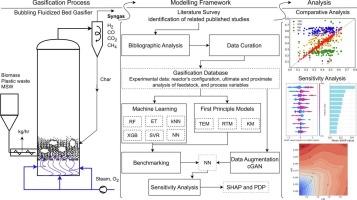Machine learning-driven modeling framework for steam co-gasification applications
IF 7.7
2区 工程技术
Q1 CHEMISTRY, APPLIED
引用次数: 0
Abstract
Steam co-gasification of biomass and plastic waste is a promising route for syngas production and waste valorization. However, accurately predicting syngas composition remains challenging due to inherent complexity and nonlinearity of the process. This study presents a comprehensive comparative analysis between conventional process simulators-based models (Aspen Plus), namely the thermodynamic equilibrium (TEM), restricted thermodynamic (RTM), and kinetic (KM) modeling approaches, and machine learning (ML) models for the prediction of the syngas composition. Using 208 experimental data points compiled from 20 published studies covering various feedstocks and gasification conditions in bubbling fluidized bed gasifiers (BFBG), the performance of the models was evaluated after extensive data preprocessing. Among several ML algorithms evaluated, the neural network (NN) delivered the lowest average root mean square error in syngas mol fraction predictions (0.0174), outperforming RTM (0.0966), KM (0.1378), and TEM (0.1470). To explore input–output relationships beyond interpolation, a conditional generative adversarial network (cGAN) generated synthetic data, which served as the basis for sensitivity and interpretability analyses. The NN, acting as a surrogate model, was paired with SHapley Additive exPlanations (SHAP) and Partial Dependence Plots (PDP) to quantify the effects and nonlinear interactions of key features on syngas yields providing actionable insights for process optimization.

蒸汽共气化应用的机器学习驱动建模框架
生物质和塑料垃圾的蒸汽共气化是合成气生产和废物增值的一条很有前途的途径。然而,由于过程固有的复杂性和非线性,准确预测合成气成分仍然具有挑战性。本研究对传统的基于过程模拟器的模型(Aspen Plus),即热力学平衡(TEM)、限制热力学(RTM)和动力学(KM)建模方法,以及用于预测合成气成分的机器学习(ML)模型进行了全面的比较分析。利用从20篇已发表的研究中收集的208个实验数据点,涵盖了鼓泡流化床气化炉(BFBG)的各种原料和气化条件,经过广泛的数据预处理后,对模型的性能进行了评估。在评估的几种ML算法中,神经网络(NN)在合成气摩尔分数预测中的平均均方根误差最低(0.0174),优于RTM(0.0966)、KM(0.1378)和TEM(0.1470)。为了探索插值之外的输入-输出关系,条件生成对抗网络(cGAN)生成了合成数据,作为敏感性和可解释性分析的基础。该神经网络作为代理模型,与SHapley加性解释(SHAP)和部分依赖图(PDP)配对,以量化合成气产量的关键特征的影响和非线性相互作用,为过程优化提供可操作的见解。
本文章由计算机程序翻译,如有差异,请以英文原文为准。
求助全文
约1分钟内获得全文
求助全文
来源期刊

Fuel Processing Technology
工程技术-工程:化工
CiteScore
13.20
自引率
9.30%
发文量
398
审稿时长
26 days
期刊介绍:
Fuel Processing Technology (FPT) deals with the scientific and technological aspects of converting fossil and renewable resources to clean fuels, value-added chemicals, fuel-related advanced carbon materials and by-products. In addition to the traditional non-nuclear fossil fuels, biomass and wastes, papers on the integration of renewables such as solar and wind energy and energy storage into the fuel processing processes, as well as papers on the production and conversion of non-carbon-containing fuels such as hydrogen and ammonia, are also welcome. While chemical conversion is emphasized, papers on advanced physical conversion processes are also considered for publication in FPT. Papers on the fundamental aspects of fuel structure and properties will also be considered.
 求助内容:
求助内容: 应助结果提醒方式:
应助结果提醒方式:


